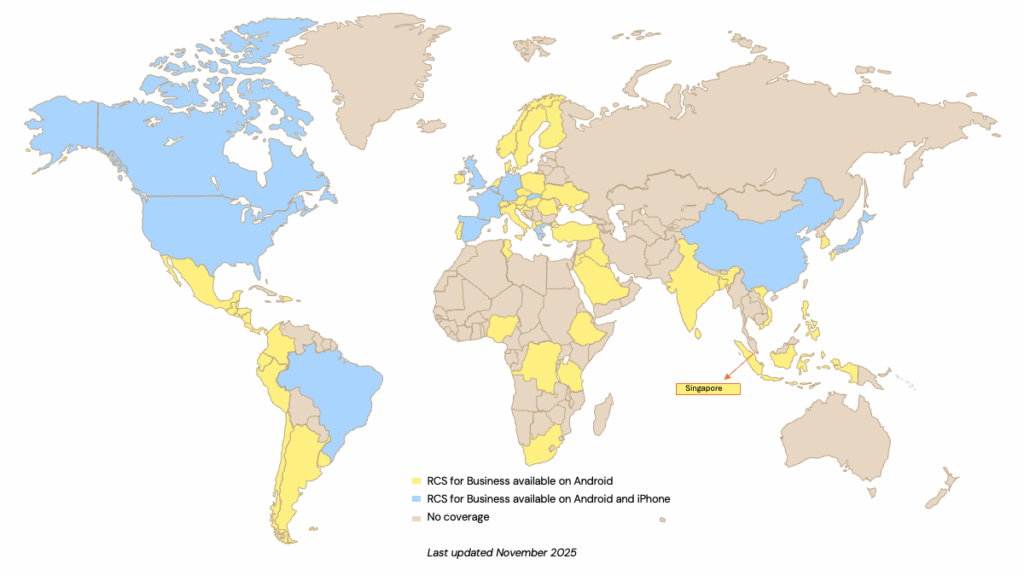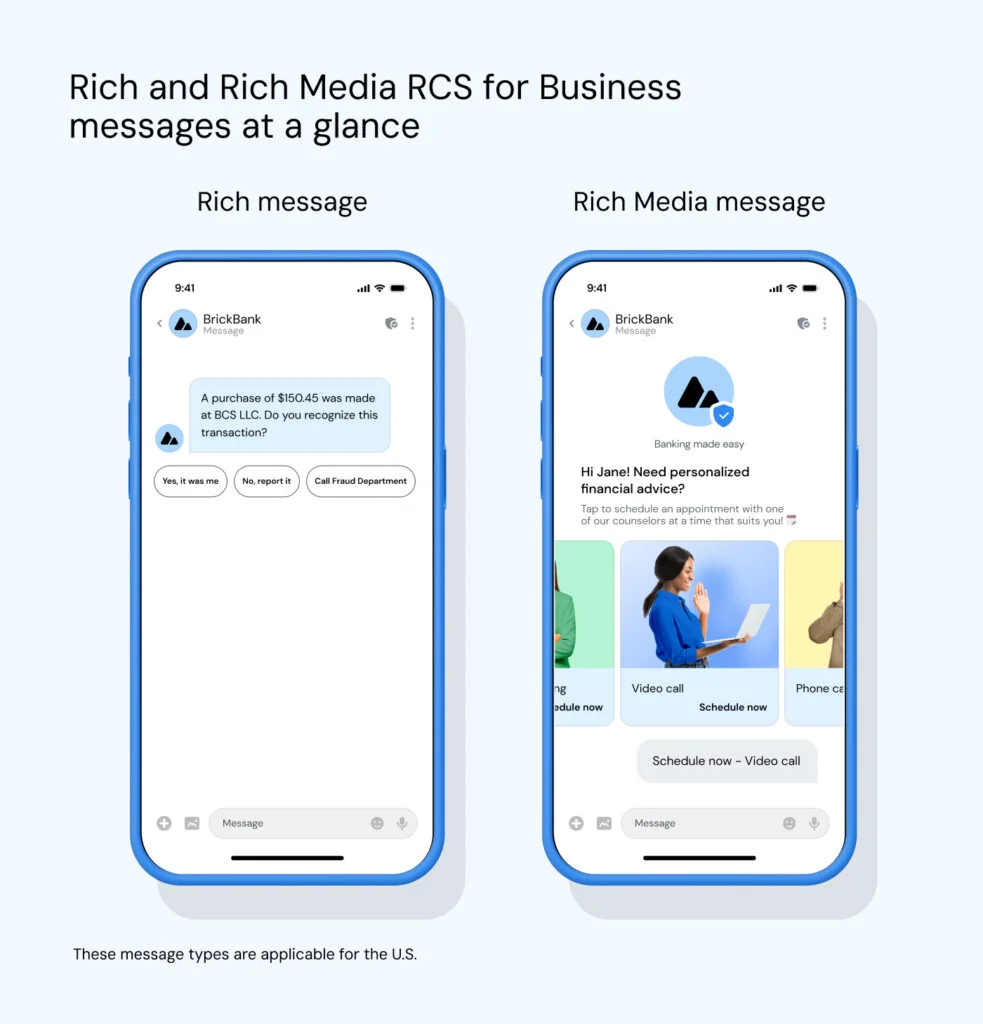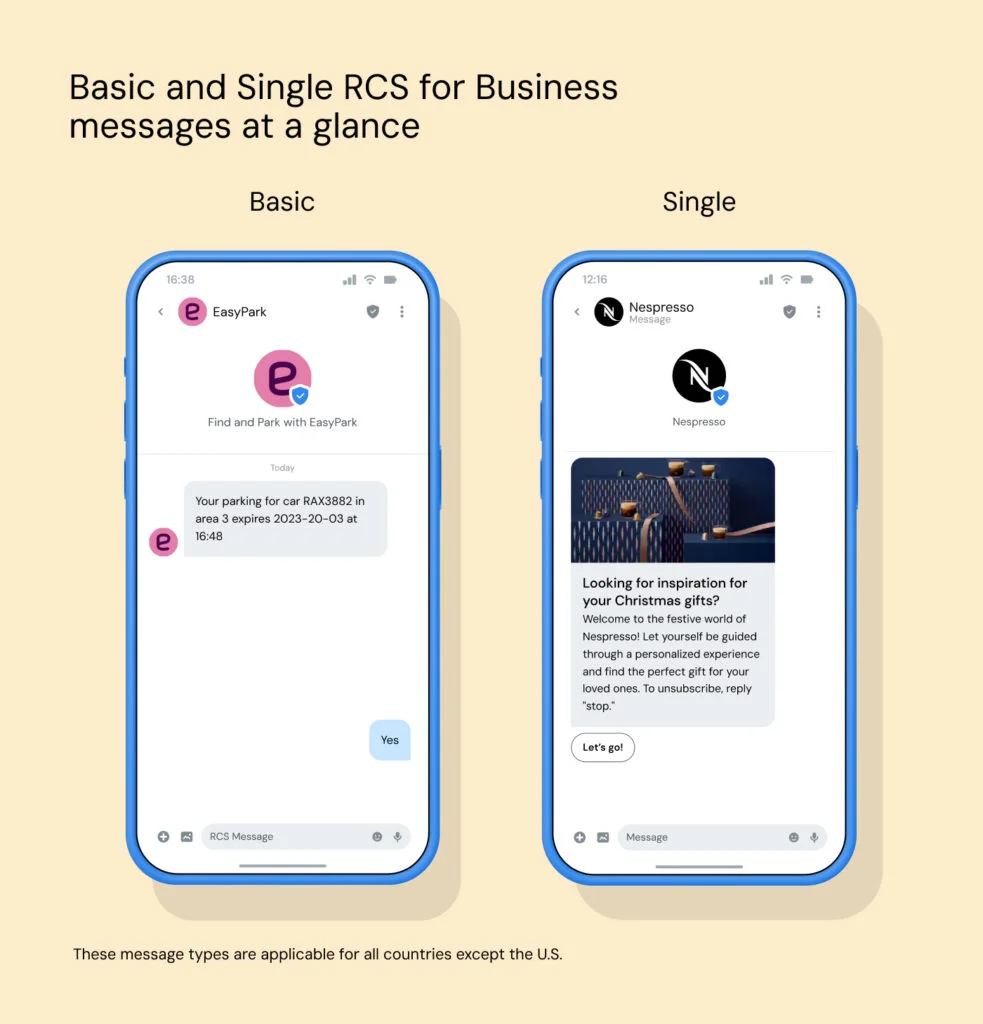Insights
How RCS pricing works for business messaging

Insights

In 2025, 84% of consumers said they’d opted in to receive text messages from businesses – that’s a 6% jump from the year before. And with Apple rolling out Rich Communication Services (RCS) support on iPhones/iOS, brands have a massive opportunity to engage consumers in fresh, exciting ways.
Why is this such a big deal? RCS messaging lets businesses send rich, branded messages that go way beyond what traditional SMS can offer, all within a customers’ native mobile messaging inbox. This means brands can grab their customers’ attention where they are already spending their time, and with a more engaging experience from the very first touch.
of consumers are opting in to receive texts from businesses
of consumers text every day
Source: SimpleTexting’s texting and SMS marketing statistics in 2025
Naturally, as more businesses explore RCS, one question comes up fast: How much does it cost, and how does it compare to SMS?
This guide breaks down how RCS pricing works, what influences the cost of each message, and what you need to know before you start sending RCS for Business messages. From getting set up to understanding message types and billing categories, we’ll walk you through it step by step.
RCS pricing determines what a business pays to send RCS for Business messages. The cost depends on the capabilities of each message – what it looks like and how your customers can interact with it. We’ll explain this in detail later.
When you send RCS for Business messages, every message comes from a verified sender profile and can include multimedia, suggested replies and actions, and more. As a business, you also get insights like opens, clicks, reads, and replies so you can measure impact. Those features add value, and in some cases that can mean a higher cost than SMS.
The way we see it, the more engaging a message is, the more potential it has to drive results. To budget well, you’ll need to understand the factors that shape RCS pricing, from how mobile carriers structure fees to the different message types you can send.
When it comes to RCS for Business (previously called RCS Business Messaging or “RBM”), pricing isn’t set by a global entity – it’s managed by mobile operators (MNOs/carriers). This means there’s no single, global price for RCS messages. Instead, RCS pricing varies depending on factors like carrier agreements, market conditions, and the message volume you’re looking to send.
If you’re considering RCS for your business, it’s important to check with your messaging provider to understand the pricing specific to your region. Since RCS is a carrier-managed service, the cost can differ significantly depending on the carrier, the market you’re in, and how much you’re messaging. Keep this in mind when planning your RCS strategy.

So, while RCS pricing is managed by carriers, it also takes into consideration the different types of RCS for Business messages that you can send. Let’s take a closer look at those next.
Brands have multiple ways to connect with customers with RCS. The RCS for Business message types they can choose between depends on their region. For the most part, Google and carriers define these categories in based on the descriptions below.
In the United States, carriers define two primary message categories:

For businesses sending RCS messages outside the United States, it’s helpful to know how carriers in other regions typically classify RCS for Business messages.

While these message types define the content you can send in your region, the way you are billed for them depends on how your RCS Agent is configured. Let’s explore those two models next.
Before you start sending RCS as a brand, you must first set up an RCS Agent, which acts as your business’s identity within the RCS ecosystem. Setting up an RCS Agent involves creating a profile, configuring your brand identity like the logo shown in your messages, defining message automation triggers, and completing the necessary verification to ensure compliance with carrier and Google guidelines.
Once your RCS Agent is set up, you can begin sending RCS for Business messages based on the preferences and configurations you’ve chosen.
Pro tip: Learn the process to set up an RCS for Business Agent via Conversation API from start to finish with this easy-to-follow, step-by-step walkthrough.
The type of RCS Agent you set up will play a key role in pricing, so it’s important to understand how that works. There are two main billing models that determine how pricing applies: non-conversational and conversational RCS Agents.
With a non-conversational RCS Agent, each message is billed separately, similar to the per-message pricing of SMS. The exact price is determined by the type of message being sent.
In the U.S., all RCS Agents operate on a non-conversational model, regardless if you’re sending Rich or Rich Media messages. In this model, two-way interactions are still possible if a customer responds to a message, but each message in the exchange is billed individually.
Outside the United States, businesses can use conversational RCS Agents to enable real-time, two-way interactions. Pricing works as follows:
The takeaway? If a user doesn’t respond, each message is charged separately, based on the message type sent (Basic or Single). If they do respond, the pricing shifts to the session-based conversational model.
Similarly, if a customer initiates a conversation with a brand and the brand replies within 24 hours, a conversation session begins and is covered by the conversational rate.
To make it easier to see the differences at a glance, here’s a table giving you a direct comparison of the two RCS Agents that determine your billing model.
| Feature | Non-conversational | Conversational |
| Billing method | Per-message | Session-based |
| Geographic availability | Standard in the United States | Available outside the United States |
| Best for | One-way notifications like OTPs or promotional alerts. | Two-way or ongoing conversations, e.g., customer support or chatbot engagements. |
| Pricing structure | Each message is billed individually by type. | A flat session rate covers all messages in a 24-hour window after the user replies. |
| Two-way interaction | Possible, but each message is charged separately. | Encouraged and cost-effective within the 24-hour session. |
Note: It’s important to remember that the names for the message types – Rich/Rich Media in the U.S. and Basic/Single outside the U.S. – are based on destination country. Both billing models can apply to these message types, but the availability of the conversational model itself is geographically limited.
To help clear up any lingering questions you may have about RCS pricing, we’ve put together some of the most common questions businesses have when exploring RCS for their messaging strategy.
RCS costs vary by carrier, region, and message volume. Some carriers might offer bulk discounts, while others may have different pricing structures based on how the RCS Agent is configured. Businesses should consult with their messaging provider for precise cost details in their target markets.
For the most part, carriers set RCS pricing based on different billing categories and usage patterns. Some factors include the type of message being sent and regional market conditions.
Typically, SMS follows a per-message pricing model. RCS pricing, on the other hand, varies depending on the message type a business is sending, and the way their RCS Agent is configured.
Outside of the U.S., a conversational agent allows businesses to send multiple messages within a session at a fixed rate, while a non-conversational agent means messages are billed separately. In the U.S., only non-conversational agents are allowed, which means a business will be billed based on if they are sending Rich messages or Rich Media messages.
Free to End User (FTEU) messaging, which is usually available for SMS, is not an option for RCS. This means that because RCS messages rely on Wi-Fi or mobile data for delivery, end users may be subject to their mobile data plans when receiving these messages. This is similar to messaging apps like WhatsApp and iMessage, where data or Wi-Fi is needed to send and receive messages.
It depends. Businesses may find some message/billing categories may have a higher per-message cost than SMS, and Conversational RCS can be more cost-effective for ongoing interactions. Since multiple messages fit into a single session, businesses doing customer support or conversational messaging with their customers will probably find it delivers better value.
It’s also important to distinguish between costs and pricing. The cost of delivering an RCS is determined by carriers, but the price a service provider charges a business can vary. At Sinch, we offer competitive pricing for RCS, often aligning it with SMS to ensure businesses get the best value.
Businesses should evaluate RCS not just based on per-message costs but on the value and engagement benefits it brings.
If your business already uses SMS, transitioning to RCS can be super simple. Many businesses will choose to start sending RCS messages using the same API and pricing that they do to send SMS – basically, an automatic capability check ensures messages send as RCS when possible, and default to SMS when not.
Or, some businesses choose to send RCS messages via a multichannel messaging platform like Sinch Engage to launch branded messaging right away. The registration requirements for an RCS Agent are the same, no matter how you choose to send RCS.
While RCS pricing varies by carrier and region, businesses can optimize costs by selecting the right messaging partner and use case for their needs.
At Sinch, we’re focused on transforming digital communications by focusing on helping businesses create real, meaningful connections with customers. RCS is just one of the tools that can help businesses do this more effectively. Whether you’re focused on customer engagement, improving service delivery, sending timely authentication messages, or offering personalized customer experiences, RCS will allow you to provide richer, more personalized interactions that keep the customer at the center of every interaction. And with higher engagement and improved ROI, investing in RCS can be well worth it.
Ready to explore how RCS can elevate your messaging? Reach out to us via the form below and see how we can help you create more meaningful connections with your customers.